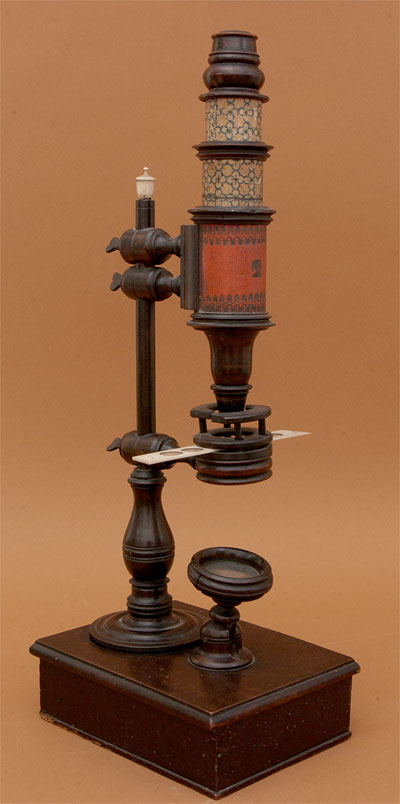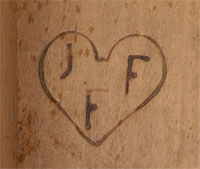Microscope No. 60 is a Nuremberg microscope made of dark wood with a turned wood pillar that fits into a rectangular wood base. There is one drawer in the base, which has a bone or ivory pull handle. The main support pillar is turned wood that has a square base peg for insertion in the base. Surrounding the foot of the pillar is a circular decorative ring. At the top of the pillar is a decorative ivory topknot. The sample stage and microscope body are supported by sliding collars fixed with wooden jam screws. The microscope body support has two collars for added stability. Specimens are mounted in a wooden Bonanni spring stage. Unfortunately the spring is missing. The microscope body fits into a cardboard tube decorated with red leather that is intricately tooled. The microscope itself consists of two cardboard tubes, with the top tube nested inside the bottom. Each tube is covered in vellum and decorated with a dyed geometric pattern. The optics are typical of that era with single objective and eye lenses. The field lens is missing from the body. A third lens, found inside the dust cap, might be the missing field lens. Samples were illuminated by a mirror mounted to the base. The mirror has a flat surface. Imaging is impossible because of the missing field lens. The microscope body is 25cm and the entire instrument is 56cm. The instrument drawer contains one bone slide consisting of six wood transverse sections and one glass microscope slide preparation.
Nuremberg-type microscopes were manufactured in the toy district of Germany (near Nuremberg) from the late 18th through the middle of the 19th Century. This area produced a large number of instruments, thus there are numerous examples in instrument collections around the world. Clay and Court (1932), described a "Nurrenberg" Culpeper-type instrument used by Ehrenberg (dated around 1820). There were two instruments in the Nachet Collection, both dated "...end of the eighteenth century or the beginning of the nineteenth century." The Museum Boerhaave has eight Culpeper-type and five sentry-box-type instruments, all dated 1800–1850. Turner (1989) describes three Nuremberg microscopes, dated "1/2 19th C". The Museo di Storia Della Scienza in Florence has two (dated "1/2 19th C"), and the Billings Collection has nine (all dated earlier). There were four styles: Culpeper-type, Sentry box-type, Solar, and Side Pillar-type. Interestingly, for such a large population all instruments look virtually identical with only minor variations in the decorations.
Featured 06/2013; 02/2022








